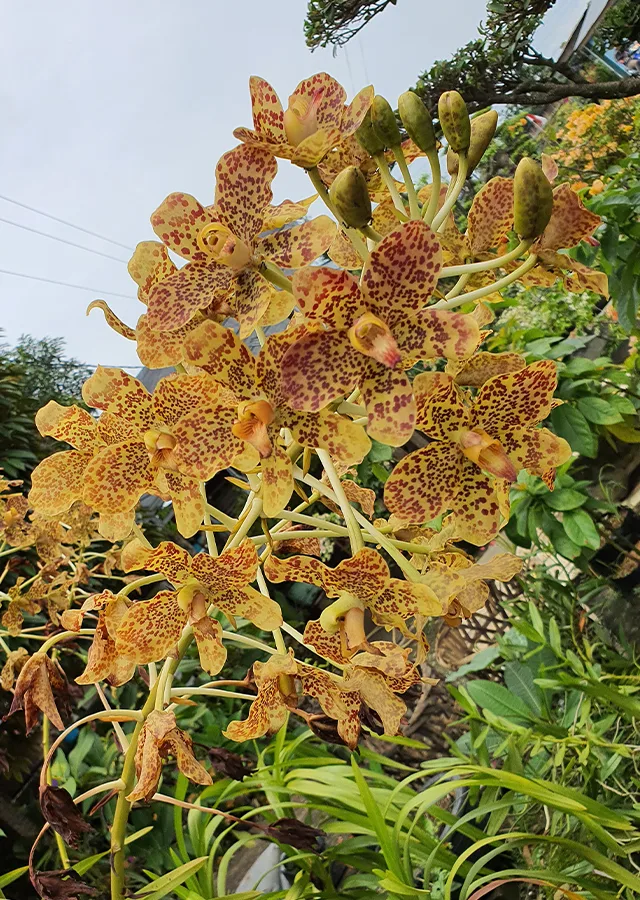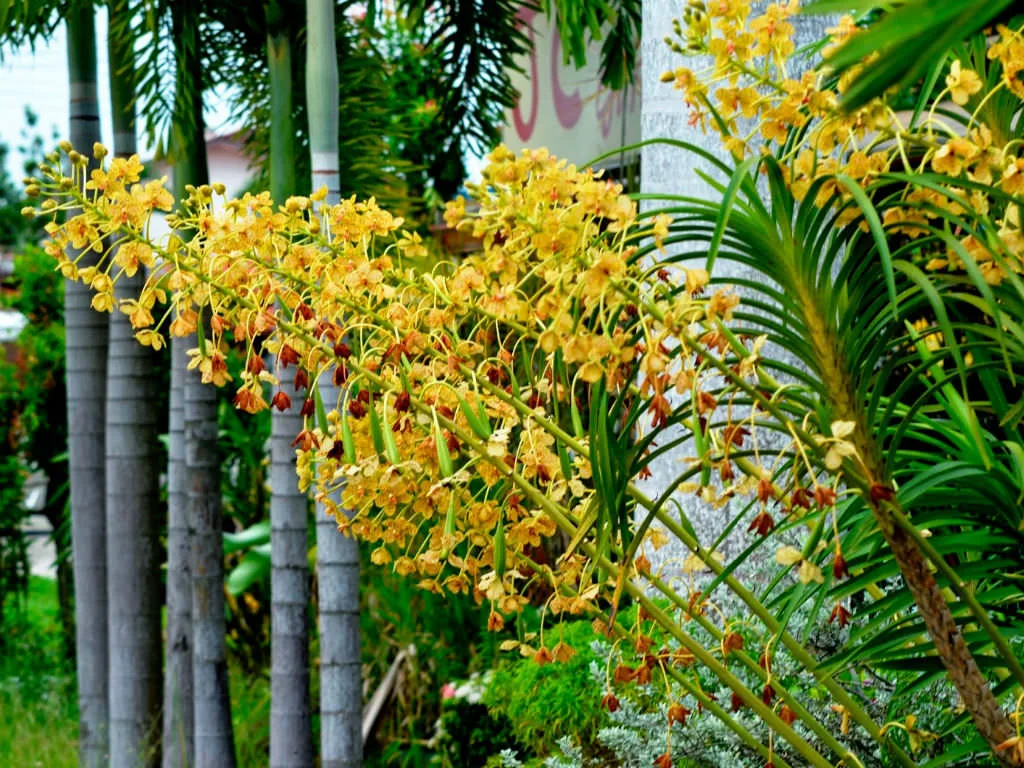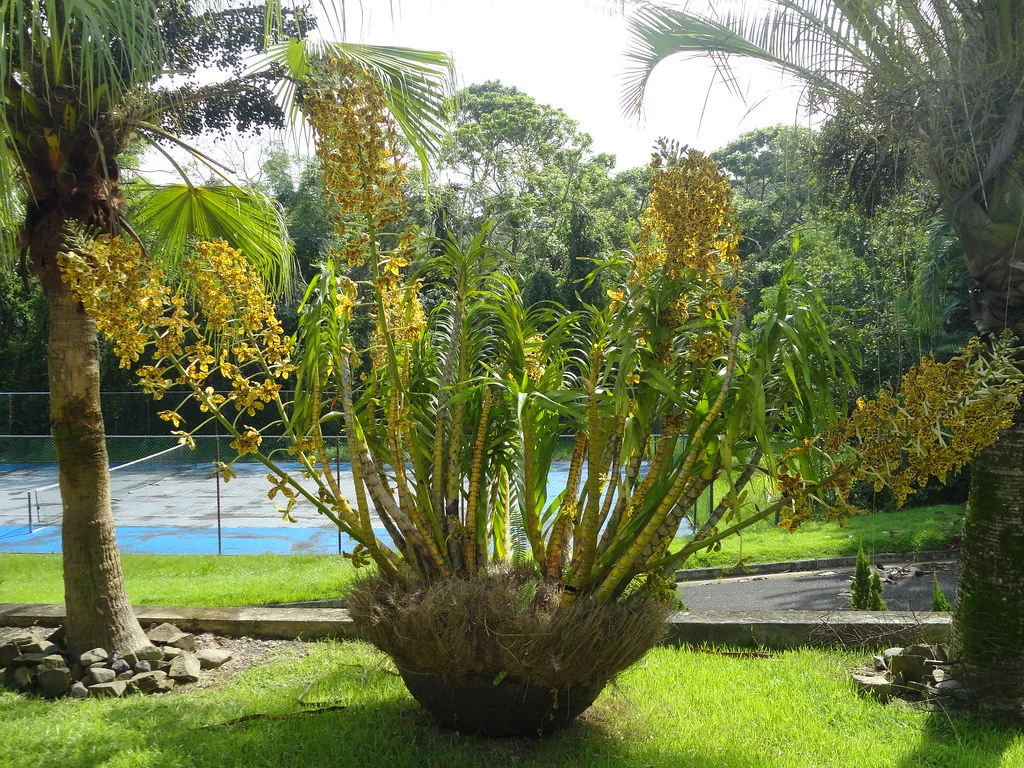table of contents
Introduction
Orchids, known for their exotic beauty, have an extraordinary representative: the Queen of Orchids (Grammatophyllum speciosum). This majestic species is recognized as the largest orchid in the world, impressing with its imposing dimensions and spectacular flowering. Originally from Southeast Asia, the Queen of Orchids stands out for its sturdy stems and large flowers that attract admirers and orchid enthusiasts all over the world.
Meaning of the Orchid Queen
In addition to its imposing stature, the Orchid Queen carries symbolic meanings. Its grandeur is often associated with majestic beauty and elegance. In the gardening world, cultivating Grammatophyllum speciosum is seen as a tribute to the harmony between nature and human care, transforming gardens into lush kingdoms. Find out more about this floral queen and immerse yourself in the fascinating world of giant orchids.
| Common Name | Queen of Orchids |
| Botanical Name | Grammatophyllum speciosum |
| Family | Orchidaceae |
| Plant Type | Epiphyte |
| Adult size | Huge, reaching several meters in height |
| Sun Exposure | Filtered sunlight or partial shade |
| Soil type | Well-drained mixture, such as bark and moss |
| soil pH | Slightly acidic to neutral (6.0 – 7.0) |
| Flowering Season | Spring to summer |
| Flower Color | Greenish-yellow, with red and brown spots |
| Native Area | Southeast Asia, including Malaysia, the Philippines and Indonesia |
| Toxicity | Not known to be toxic |

How to Care for the Queen of Orchids
Light
To ensure the lush flowering of the Orchid Queen, sun exposure is crucial. Filtered light or partial shade is ideal. Avoid intense direct sunlight, opting for a location that provides soft lighting.
Soil
The type of soil plays a vital role in growing Grammatophyllum speciosum. Use a well-drained mixture such as bark and moss. This combination provides an environment conducive to healthy root development.
Water
Proper water management is essential. The Orchid Queen prefers a moderate watering regime, allowing the substrate to dry out between waterings. Avoid waterlogging, as this can lead to root problems.
Temperature and humidity
Keep the orchid in conditions of moderate temperature and high humidity. This species thrives in tropical climates. Ensure a constant temperature and avoid exposure to cold drafts.
Fertilizing
Fertilize Grammatophyllum speciosum regularly during the growing season. Opt for balanced orchid fertilizers. Follow the application instructions and adjust as necessary, providing the essential nutrients for lush growth.
By following these care guidelines, you will be fostering an environment conducive to the Orchid Queen thriving, displaying all its majesty and beauty.
How to propagate the Queen of Orchids
Grammatophyllum speciosum can be propagated through cuttings, allowing you to expand your orchid collection. Follow these steps to make successful cuttings:
- Choosing Healthy Seedlings:
- Select healthy and robust lateral shoots for propagation.
- Make sure that the cuttings you choose are free of diseases and pests.
- Precise cutting:
- Use a sharp tool to make clean cuts on the seedlings.
- Cut close to the main stem, ensuring that the seedling has a piece of stem attached.
- Preparing the substrate:
- Use a suitable substrate, such as a mixture of bark and perlite.
- Ensure good aeration and drainage to promote rooting.
- Planting the seedlings:
- Plant the cuttings in the prepared substrate, pressing gently to secure them.
- Keep the soil slightly moist during the rooting period.
- Suitable environment:
- Place the cuttings in a location with filtered light, avoiding direct sunlight.
- Maintain a high level of humidity around the seedlings.

How to plant the Queen of Orchids
When planting Queen Orchids, it is essential to provide the ideal conditions for healthy development. Follow these steps to plant successfully:
- Choosing a pot:
- Opt for a spacious pot, allowing the roots to grow.
- Make sure the container has drainage holes.
- Preparing the soil:
- Prepare a suitable substrate by mixing bark, moss and perlite.
- Make sure the mixture is well aerated and drained.
- Orchid placement:
- Plant the Grammatophyllum speciosum in the center of the pot, leaving room for growth.
- Make sure the roots are evenly distributed.
- Initial watering:
- After planting, carry out an initial watering to establish the substrate around the roots.
- Avoid waterlogging by allowing the soil to dry out between waterings.
- Proper maintenance:
- Place the pot in a location with filtered light, avoiding intense sunlight.
- Regularly monitor soil moisture and water needs.
By following these guidelines for making seedlings and planting the Orchid Queen, you will be promoting healthy growth and ensuring the success of your exotic orchid collection.
Most common pests and diseases
When growing the Orchid Queen, it’s crucial to be aware of the pests and diseases that can affect its health. Here’s a list of the most common ones:
- Mites:
- Symptoms: Fine webs and spots on the leaves.
- Solution: Use neem oil or insecticidal soap.
- Mealybugs:
- Symptoms: White or padded spots on the leaves.
- Solution: Remove by hand or use neem oil.
- Root rot:
- Symptoms: Dark and soft roots.
- Solution: Repot the orchid in a well-drained substrate.
- Mildew:
- Symptoms: Whitish spots on the leaves.
- Solution: Treat with appropriate fungicides.
- Bacterial spots:
- Symptoms: Watery spots on the leaves.
- Solution: Remove the affected areas and treat with plant antibiotics.

Common problems and their solutions
In addition to specific pests and diseases, some common problems can arise when growing the Orchid Queen. Here are some common situations and their solutions:
- Yellow leaves:
- Cause: Overwatering or lack of nutrients.
- Solution: Adjust the watering regime and provide balanced fertilizers.
- Lack of flowers:
- Cause: Unsuitable growing conditions.
- Solution: Evaluate light, temperature and fertilization; adjust as necessary.
- Slow growth:
- Cause: Lack of nutrients or unsuitable growing conditions.
- Solution: Fertilize regularly and adjust growing conditions.
By being aware of these potential problems and their solutions, you can keep your Orchid Queen healthy and vibrant, ensuring successful cultivation.
Curiosities and Myths
Explore the fascinating world of Grammatophyllum speciosum through curiosities and myths related to this magnificent orchid.
Curiosities about the Queen of Orchids
- Largest Orchid in the World:
- The Grammatophyllum speciosum is recognized as the largest orchid in the world, reaching impressive dimensions.
- Spectacular blooms:
- Its flowers are not only large, but also offer a visual spectacle with their vibrant colors.
- Surprising longevity:
- This orchid can live for decades, providing years of continuous beauty to those who grow it.
- Tropical Origins:
- Native to the tropical regions of Southeast Asia, the Queen of Orchids thrives in hot and humid climates.
Myths surrounding the Queen Orchid
- Difficult to grow:
- Myth: Although imposing, Grammatophyllum speciosum can be grown successfully with the right care.
- Requires Excessive Space:
- Myth: Despite its impressive size, the Queen of Orchids can be adapted to growing in pots, making it a viable option for smaller gardens.
- Highly Toxic:
- Myth: There is no significant evidence of toxicity associated with Grammatophyllum speciosum, making it safe to grow.
Unravel these intriguing curiosities and break the myths surrounding the Queen of Orchids by discovering more about this incredible floral species.

Conclusion
Throughout the pages of this guide, we have explored the secrets and care needed to grow the magnificent Grammatophyllum speciosum, known as the Queen of Orchids. From the presentation of its grandeur to the detailed guidelines for planting, propagating and overcoming challenges, each section offers a deep dive into the dazzling universe of this remarkable orchid. By understanding the processes of flowering, pollination and harvesting, we unraveled the mysteries that make this floral queen a majestic addition to any garden.
To recap, the Grammatophyllum speciosum is not only the largest orchid in the world, but also a masterpiece of nature, standing out for its spectacular flowers and surprising longevity. We demystify mistaken beliefs, showing that, with the right care, cultivating this queen is not only possible, but rewarding. By embarking on the journey of growing the Queen of Orchids, you not only reap lush fruit, but also experience the beauty and charm that this extraordinary species has to offer. Cultivate your own floral majesty and witness the unique splendor of Grammatophyllum speciosum bloom in its own green sanctuary.
Frequently Asked Questions
What is the largest orchid in the world?
The largest orchid in the world is the Grammatophyllum speciosum, also known as the Queen of Orchids. Originally from Southeast Asia, this impressive species is renowned for its imposing size and spectacular flowers. Its cultivation requires special attention due to its size, and it is essential to provide the ideal conditions of light, soil and water to ensure healthy development.
How to grow Grammatophyllum speciosum?
Growing Grammatophyllum speciosum requires specific care. This large orchid needs filtered light, well-drained soil and a moderate watering regime. Choosing a location, preparing the soil properly and paying attention to signs of growth are essential. In addition, successful cultivation involves managing common pests and diseases, ensuring that the Queen of Orchids blooms with splendor.







